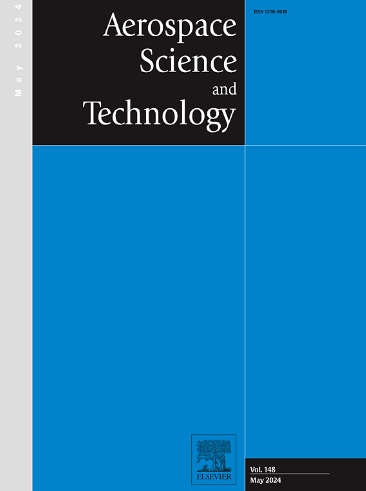Penetration of oblique shock wave through different thickness boundary layers
IF 5
1区 工程技术
Q1 ENGINEERING, AEROSPACE
引用次数: 0
Abstract
Compression flows, characterized by high Reynolds numbers, typically sustain intense temperature gradients along the wall-normal near the surface due to high viscous dissipation, resulting in a thicker, more unstable developing turbulent boundary layer. In scenarios with large streamwise scales, such as scramjet inlets, where numerous shock waves are present, interactions between varying boundary layer thicknesses and oblique shocks are prevalent. This study investigates these interactions using a configuration involving two different plate turbulent boundary layers, generated by roughness elements arrayed at the leading edge of the plate, and a 37.5° oblique shock. Flow visualization, conducted using Nano-tracer Planar Laser Scattering (NPLS), shows that vortex heads are squeezed into small-scale structures by the discontinuous shock. Velocity fields, measured by Particle Image Velocimetry (PIV), combined with a novel density calibration scheme proposed in this study, are employed to quantitatively analyze the impact of shock waves on the two different thickness boundary layers. The separation region exhibits a similar wall-normal direction scale in both cases, while the streamwise scale extends to 3.4 mm in the thin boundary layer and 4.4 mm in the thicker one. Significant density fluctuations are observed in the reattachment region. Spectral analysis at four wall-normal positions highlights notable distinctions depending on boundary layer thickness. Due to the impingement of the strong oblique shock, the turbulent boundary layer downstream of separation region, originating from the reattachment region, becomes more unstable than the upstream boundary layer, with the power of the universal spectrum increasing by 5-10 times compared to upstream regions. These findings indicate that turbulent boundary layers downstream of multiple shock-wave boundary layer interaction regions exhibit more complex and unstable characteristics, distinct from naturally developing boundary layers.

求助全文
约1分钟内获得全文
求助全文
来源期刊

Aerospace Science and Technology
工程技术-工程:宇航
CiteScore
10.30
自引率
28.60%
发文量
654
审稿时长
54 days
期刊介绍:
Aerospace Science and Technology publishes articles of outstanding scientific quality. Each article is reviewed by two referees. The journal welcomes papers from a wide range of countries. This journal publishes original papers, review articles and short communications related to all fields of aerospace research, fundamental and applied, potential applications of which are clearly related to:
• The design and the manufacture of aircraft, helicopters, missiles, launchers and satellites
• The control of their environment
• The study of various systems they are involved in, as supports or as targets.
Authors are invited to submit papers on new advances in the following topics to aerospace applications:
• Fluid dynamics
• Energetics and propulsion
• Materials and structures
• Flight mechanics
• Navigation, guidance and control
• Acoustics
• Optics
• Electromagnetism and radar
• Signal and image processing
• Information processing
• Data fusion
• Decision aid
• Human behaviour
• Robotics and intelligent systems
• Complex system engineering.
Etc.
 求助内容:
求助内容: 应助结果提醒方式:
应助结果提醒方式:


